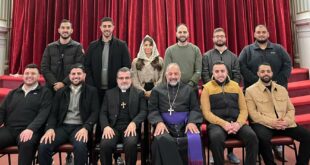On the night the fire destroyed their church, some members of the local Assyrian community said they felt as if a loved one had died.
But as any Assyrian will tell you, nothing can shake their rock solid faith.
So they pulled together, held fundraisers, worked and prayed until little by little, stone by stone, another church rose from the ashes.
On Sunday, for the first time in three years, the Assyrians of St. Mary’s parish will recite their ancient prayers in an all new sanctuary.
“The church has been resurrected,” said an elated Rev. George Bet-Rasho of St. Mary’s Holy Apostolic Catholic Assyrian Church of the East, in Tarzana.
“When the church burned down three years ago, we felt like the Apostles must have felt when Jesus was crucified. We were saddened,” he said. “Now we feel as they must have felt, when he rose and they saw him again.”
On Thursday, a flurry of construction workers labored over some last minute details to make the church ready for a ribbon-cutting ceremony to be held Saturday.
Bet-Rasho said the fire, while painful to see, allowed the community to build their church in the traditions they wanted.
“We wanted a church that stayed true to both the California mission style and the Church of the East,” Bet-Rasho said.
That tradition includes constructing an altar that faces east. And from top to bottom of the sanctuary, each part of the church is symbolic, from the flaxen-colored Jerusalem stone floors, to the stained glass windows that feature familiar images from the Old and New Testaments, to the ceiling painted in sky blue, to remind worshippers of heaven. Prayers in Aramaic, the language spoken during the Mass, will also welcome those who enter.
Churchgoers who have watched the construction say they are in disbelief. Josephine Dizayer watched three years ago as the fire sent flames 150 feet from the old church’s soaring stained glass windows, into the darkening sky.
“I look at this whole thing as if it were a miracle,” Dizayer said now. “There was so much work from so many people, financially, physically, spiritually, to have this. I’m very happy.”
The blaze blackened the white brick facade of the old church, charred pews, drapes, vestments and even some books written in Aramaic.
One of those books, the Gospels, survived. Its edges singed but otherwise legible, the book will be placed on a special shelf for all to see.
That the book survived also is a metaphor for the community. Assyrians trace their ancestral lands to what is now known as Iraq, where the last and largest concentration of Aramaic-speaking people in the world have lived for thousands of years. Those who follow the Church of the East trace their origins to 33 A.D. But they have no country to call their own. In the early 20th century, 750,000 Assyrians died in the Ottoman Empire and in Iran during what is more commonly known as the Armenian genocide. There were 3,000 killed in Iraq in a 1933 massacre.
In recent years, St. Mary’s has seen more members come from war-torn Iraq and other countries, as Christians from their ancestral homeland continue to escape Islamic extremism. Still, they persevere.
Bet-Rasho has estimated there are more than 40,000 Assyrians in California and about 10,000 in the Los Angeles area.
At least 1,000 families belong to St. Mary’s parish, which moved to the Lindley Avenue church in Tarzana 15 years ago, from North Hollywood.
Charles Begini, the former president of the church board, called the new church a blessed achievement.
“Especially for us as minorities, to be able to achieve such a wonderful project, is amazing,” he said. “Here in the United States, there is a feeling of freedom, to be able to practice your religion with no fear at all.”
Bet-Rasho said that while Assyrian hands designed and constructed the church, its overall existence comes from a higher power.
“If you submit to God,” Bet-Rasho said, “good things happen.”
[nggallery id=403] Assyrian Church News Official News Site of the Holy Apostolic Catholic Assyrian Church of the East
Assyrian Church News Official News Site of the Holy Apostolic Catholic Assyrian Church of the East

